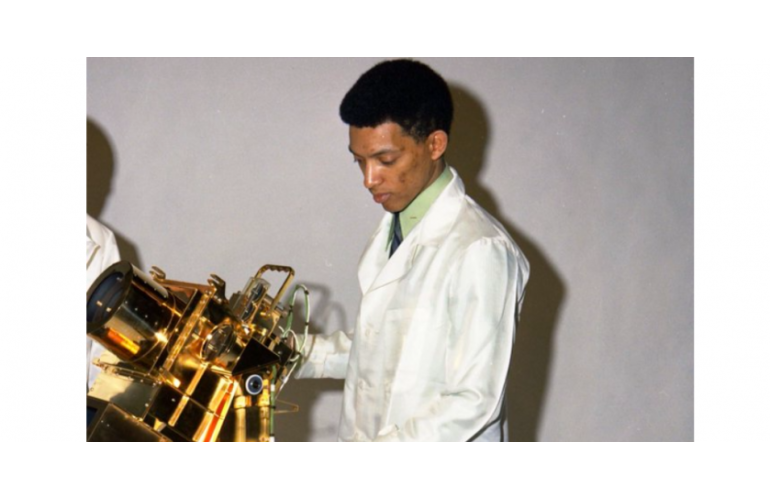Biography of George Carruthers
Early Life and Education
George Robert Carruthers was born on October 1, 1939, in Cincinnati, Ohio. His early fascination with science, particularly astronomy, was influenced significantly by the passing of his father, an Air Force civil engineer, when George was only 12. His father’s interest in science and mechanics left a lasting impact on him. Raised by his mother, Sophia Carruthers, George nurtured his passion by reading extensively about astronomy and building model rockets.
Carruthers pursued his academic interests fervently, graduating from high school in Chicago and enrolling at the University of Illinois at Urbana-Champaign. There, he earned a Bachelor of Science degree in Aeronautical Engineering in 1961, followed by a Master of Science in Nuclear Engineering in 1962, and finally a Ph.D. in Aeronautical and Astronautical Engineering in 1964.
Career and Achievements
After completing his Ph.D., George Carruthers began working at the Naval Research Laboratory (NRL) in Washington, D.C., where he made significant contributions to ultraviolet astronomy and space science. His most notable invention, developed in 1969, was the Far Ultraviolet Camera/Spectrograph, the first moon-based observatory. This device was deployed during the Apollo 16 mission in 1972 and provided crucial data about the Earth’s atmosphere and space phenomena, including vast images of celestial objects in ultraviolet light.
Throughout his career, Carruthers developed numerous other instruments for observing space. His work helped to confirm molecular hydrogen’s presence in interstellar space and provided detailed images of various celestial phenomena.
Contributions to Science and Community
George Carruthers is renowned not only for his scientific achievements but also for his dedication to education and community outreach. He was an advocate for science education, particularly encouraging minority students to pursue scientific careers. Carruthers held workshops, gave lectures, and was involved with organizations aimed at promoting science among underrepresented groups.
Legacy and Recognition
Carruthers’ contributions to science have been widely recognized. He received the National Medal of Technology and Innovation in 2003, one of the highest honors bestowed by the President of the United States for achievements related to technological progress. He was also inducted into the National Inventors Hall of Fame in 2003.
Carruthers passed away on December 26, 2020, leaving behind a legacy that transcends his time spent on Earth, as his work continues to influence the fields of astronomy and aerospace engineering.
Top 20 Questions About George Carruthers
- When and where was George Carruthers born?
- October 1, 1939, in Cincinnati, Ohio.
- What sparked his interest in astronomy?
- His father’s early influence and his own readings on astronomy.
- Where did George Carruthers go to college?
- University of Illinois at Urbana-Champaign.
- What degrees did he earn?
- BS in Aeronautical Engineering, MS in Nuclear Engineering, and Ph.D. in Aeronautical and Astronautical Engineering.
- What was George Carruthers’ most significant invention?
- The Far Ultraviolet Camera/Spectrograph.
- How did his invention impact the Apollo missions?
- It was used in Apollo 16 to gather important data from the moon.
- What awards did George Carruthers receive?
- He was awarded the National Medal of Technology and Innovation and was inducted into the National Inventors Hall of Fame.
- Did George Carruthers have any children?
- There is no public record of him having children.
- How did George Carruthers contribute to education?
- He was involved in educational outreach and encouraged minority students to pursue careers in science.
- When did George Carruthers pass away?
- December 26, 2020.
- What are some other inventions or contributions by Carruthers?
- He developed instruments that confirmed molecular hydrogen in interstellar space and provided detailed images of the upper atmosphere.
- How did Carruthers’ invention get to the moon?
- It was carried aboard Apollo 16.
- Did he ever teach at any universities?
- There is no public record of him having a formal teaching position, but he was involved in many educational programs and workshops.
- What inspired George Carruthers to become a scientist?
- His early passion for astronomy and the influence of his father.
- How did his work impact the understanding of space?
- His work provided new insights into celestial phenomena and the composition of interstellar space.
- Did George Carruthers receive any honorary degrees?
- Specific honorary degrees are not listed, but he received numerous awards and recognitions for his work
.
- Was George Carruthers married?
- Details about his personal life, such as marital status, are not widely publicized.
- What was his role at the Naval Research Laboratory?
- He was a principal researcher and invented several astronomical instruments there.
- How has his legacy been preserved?
- His legacy continues through the ongoing use and impact of his scientific contributions and his influence in science education.
- What did George Carruthers do after retiring?
- Details about his life post-retirement are limited, but he remained active in science education and outreach.





